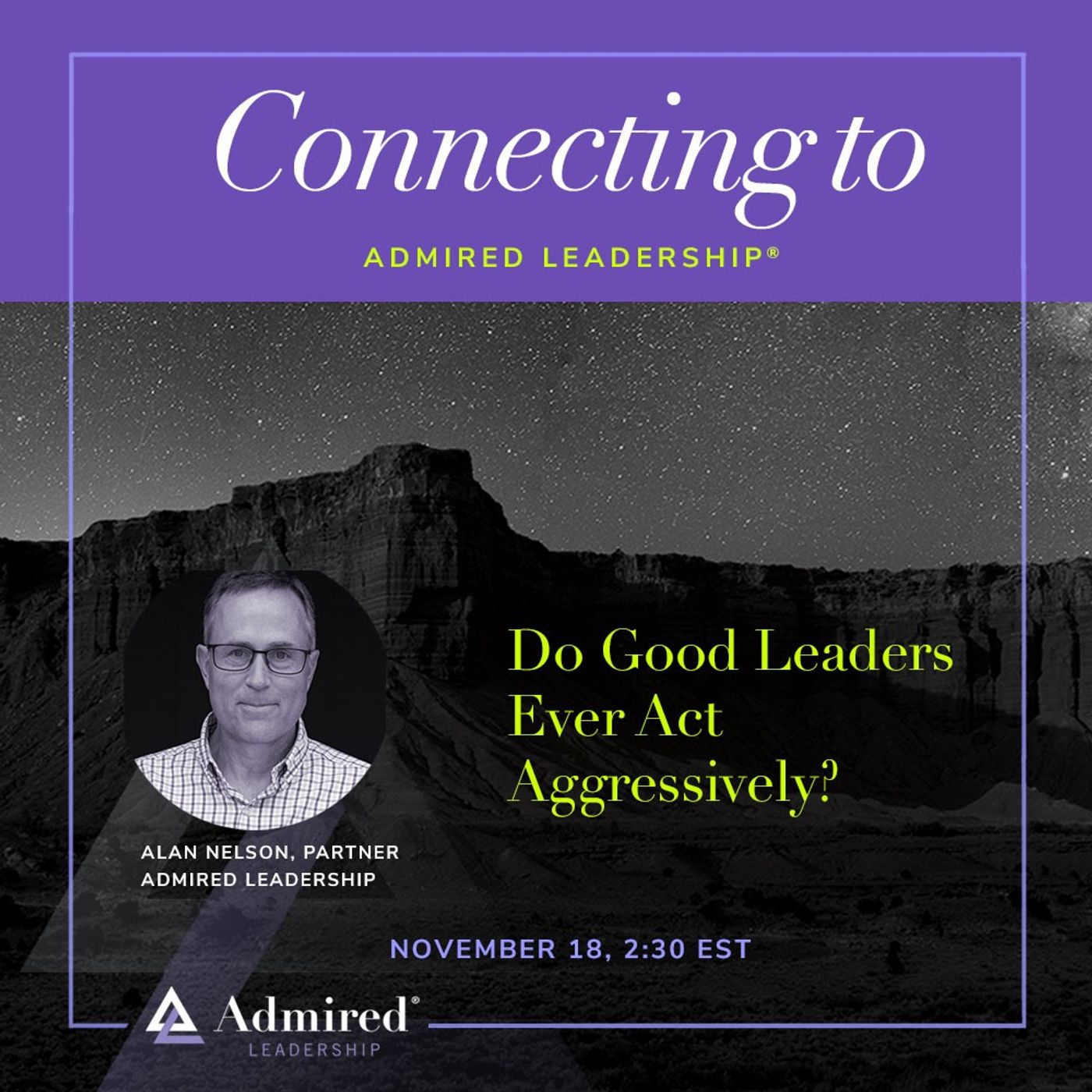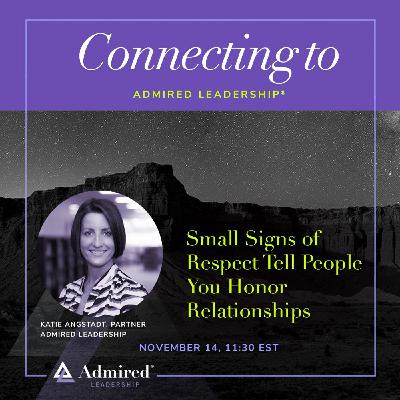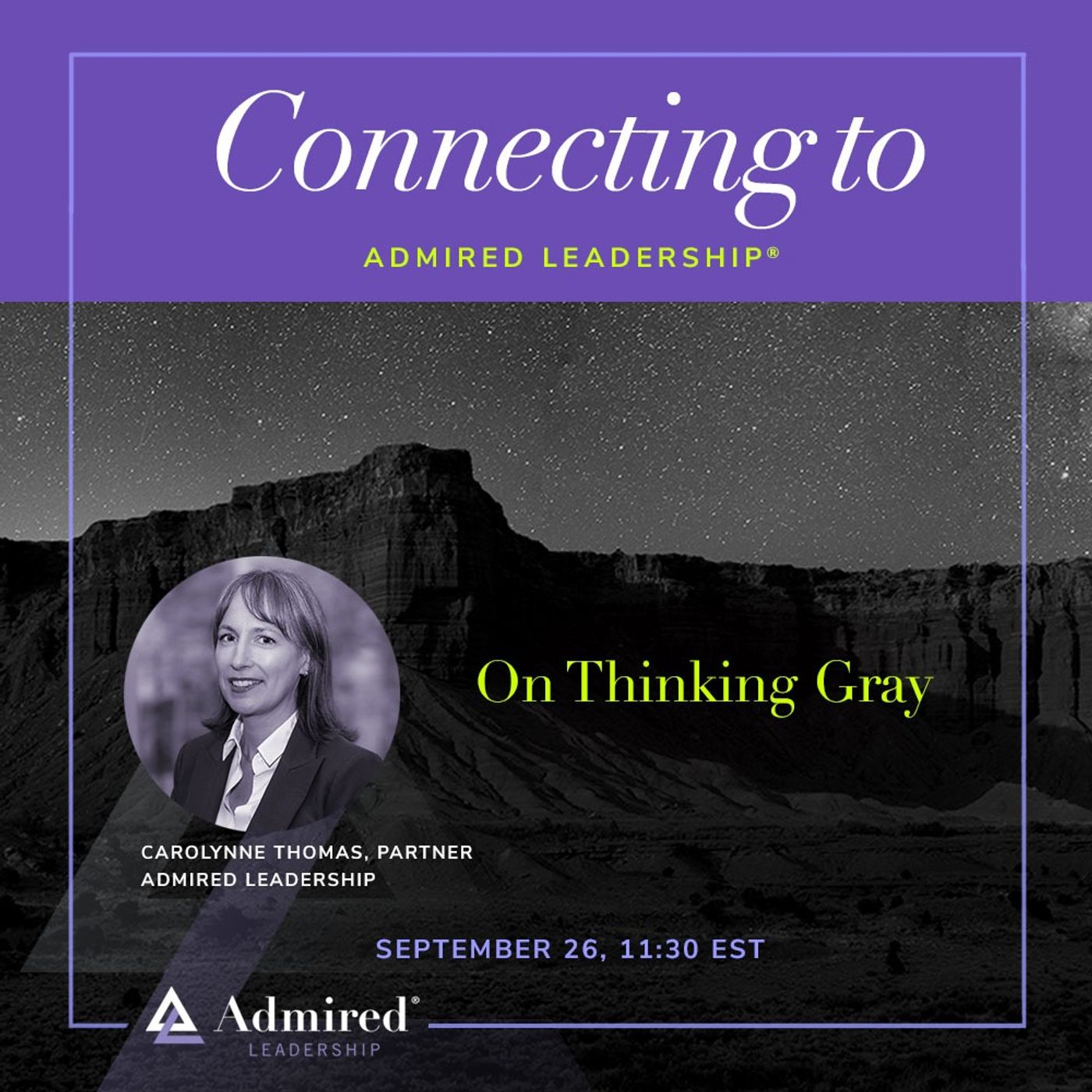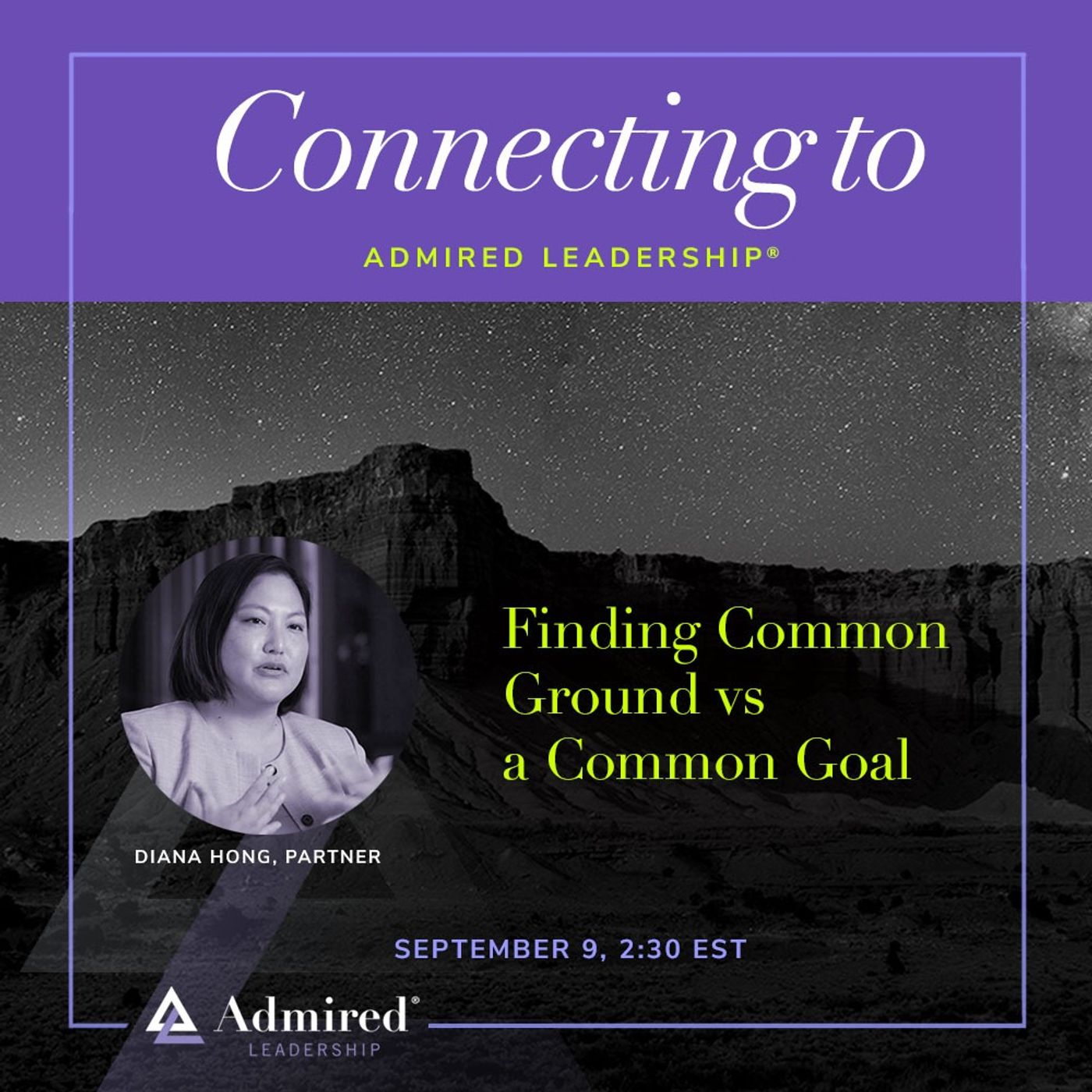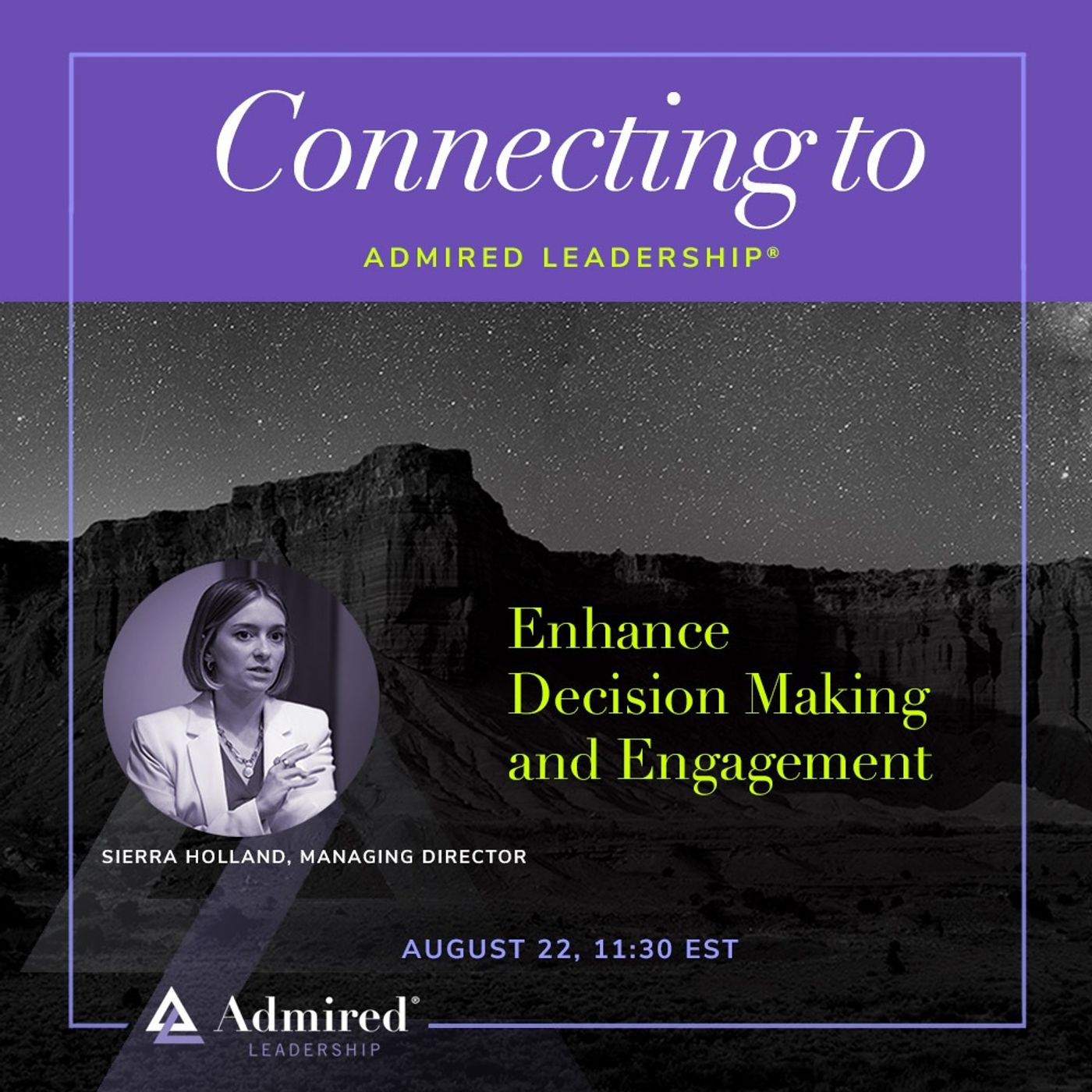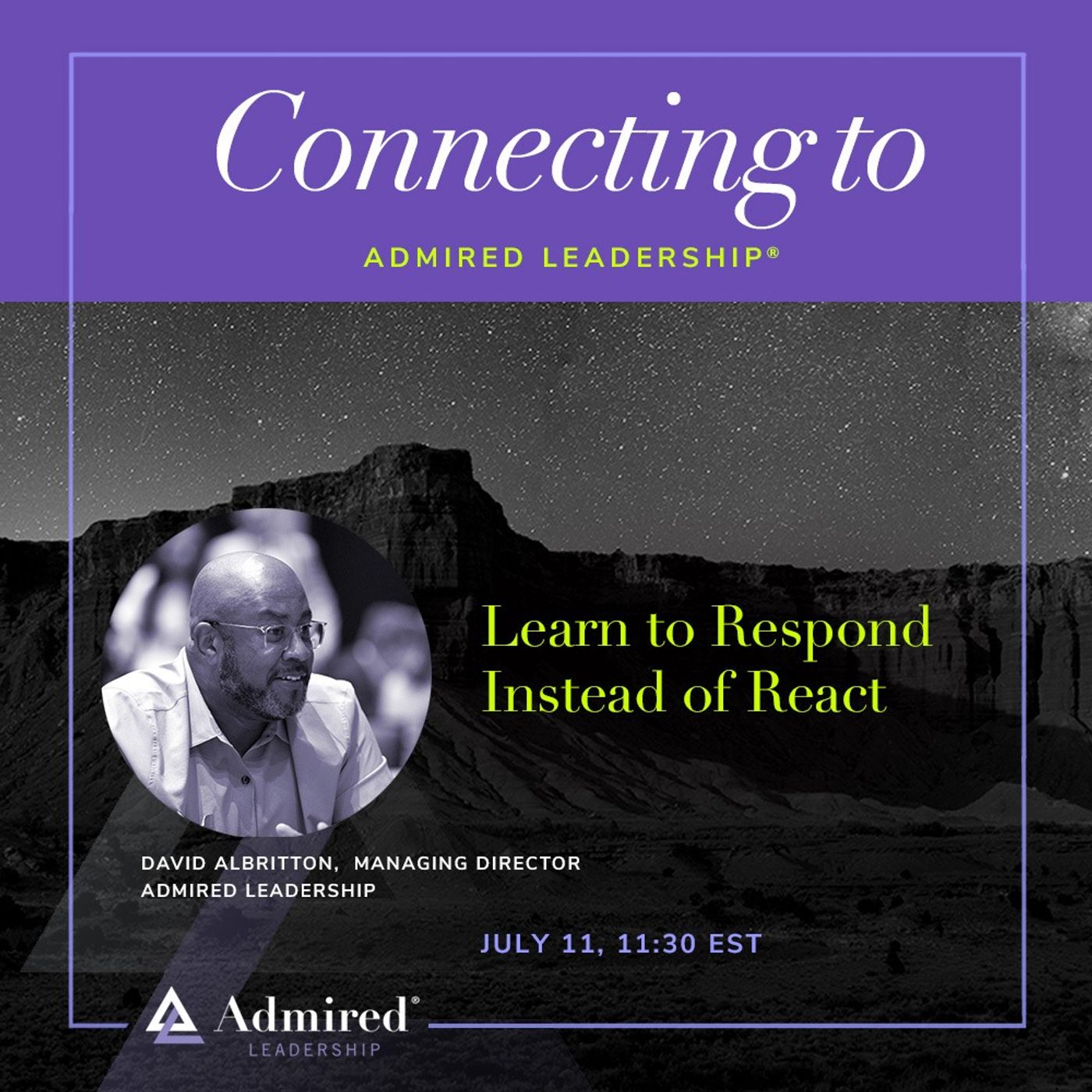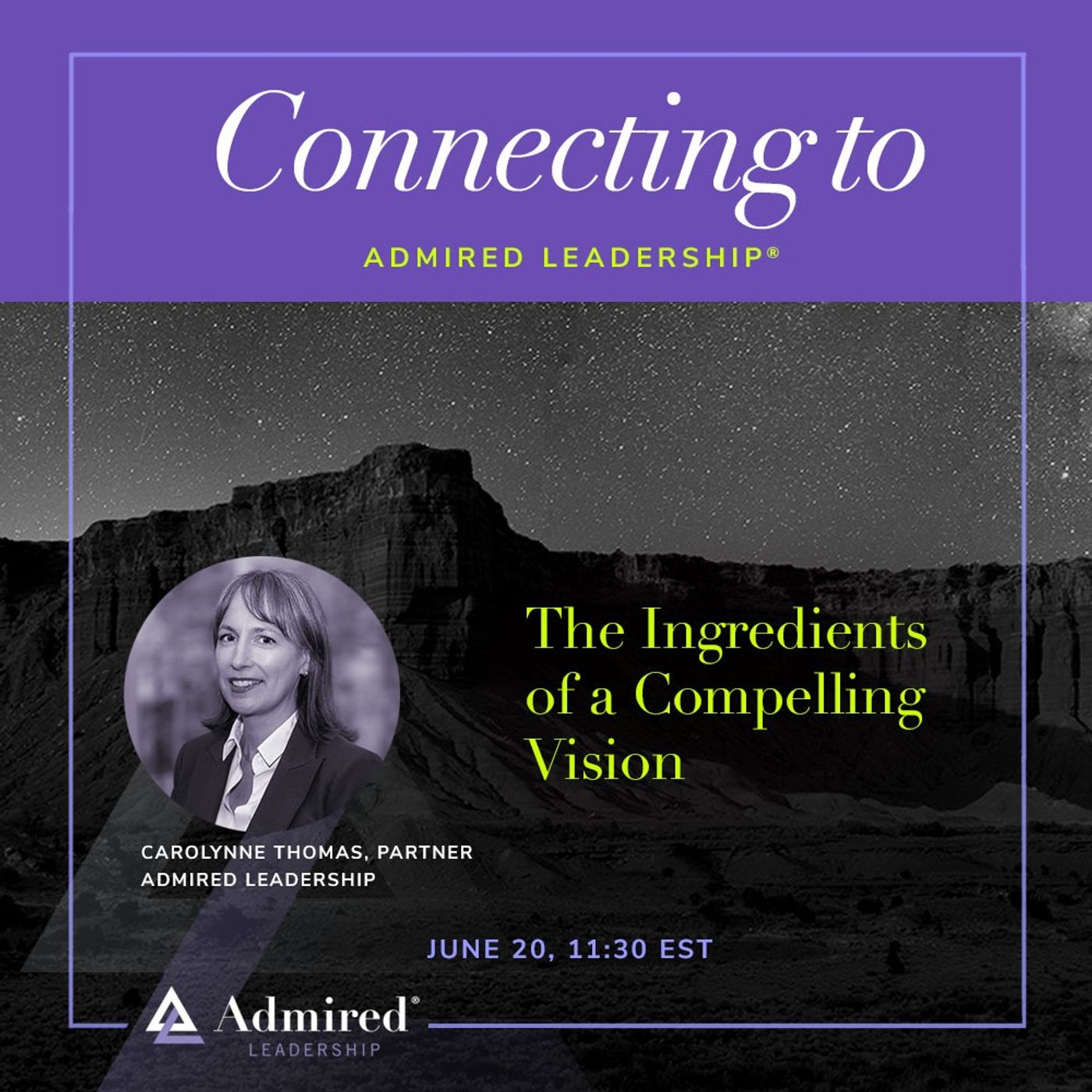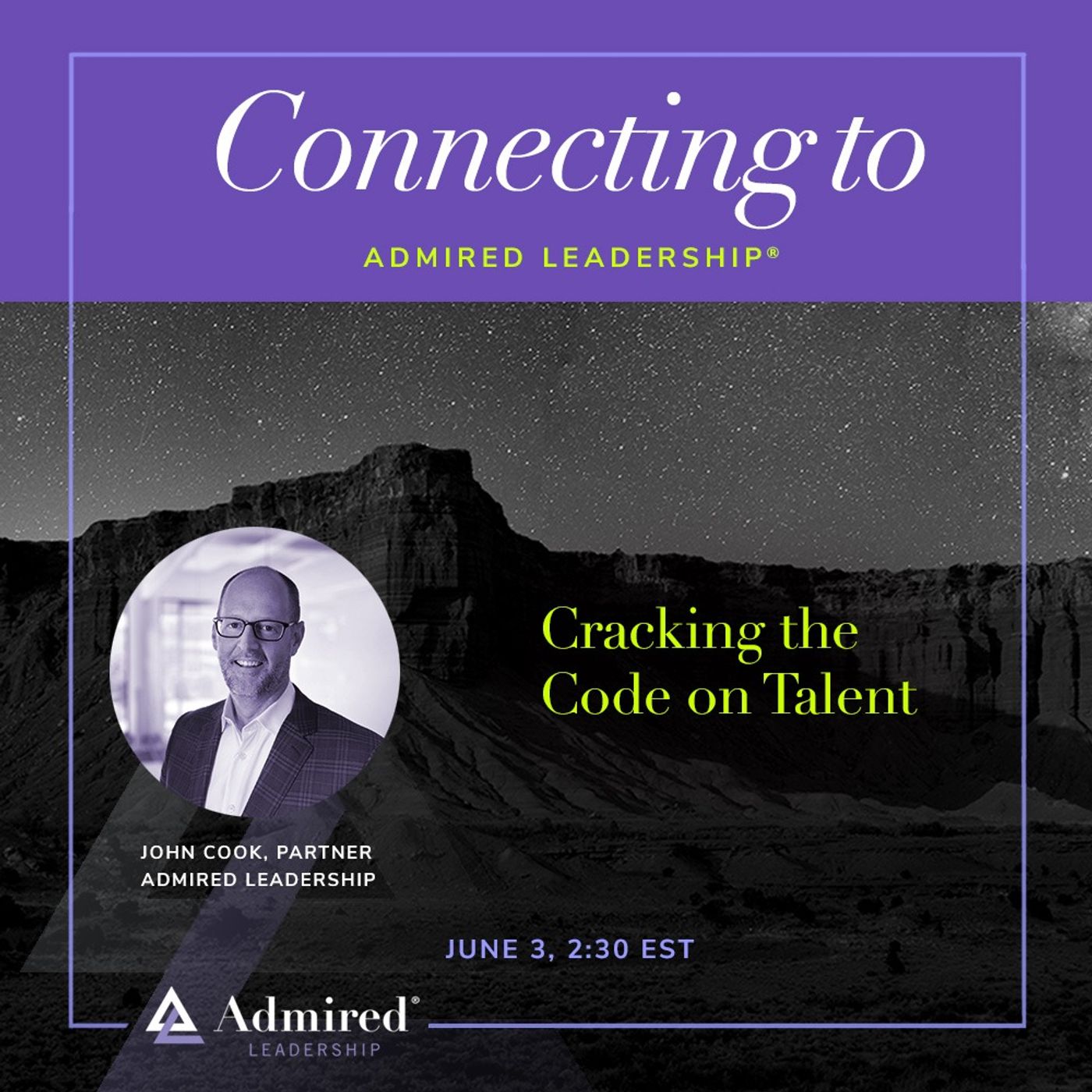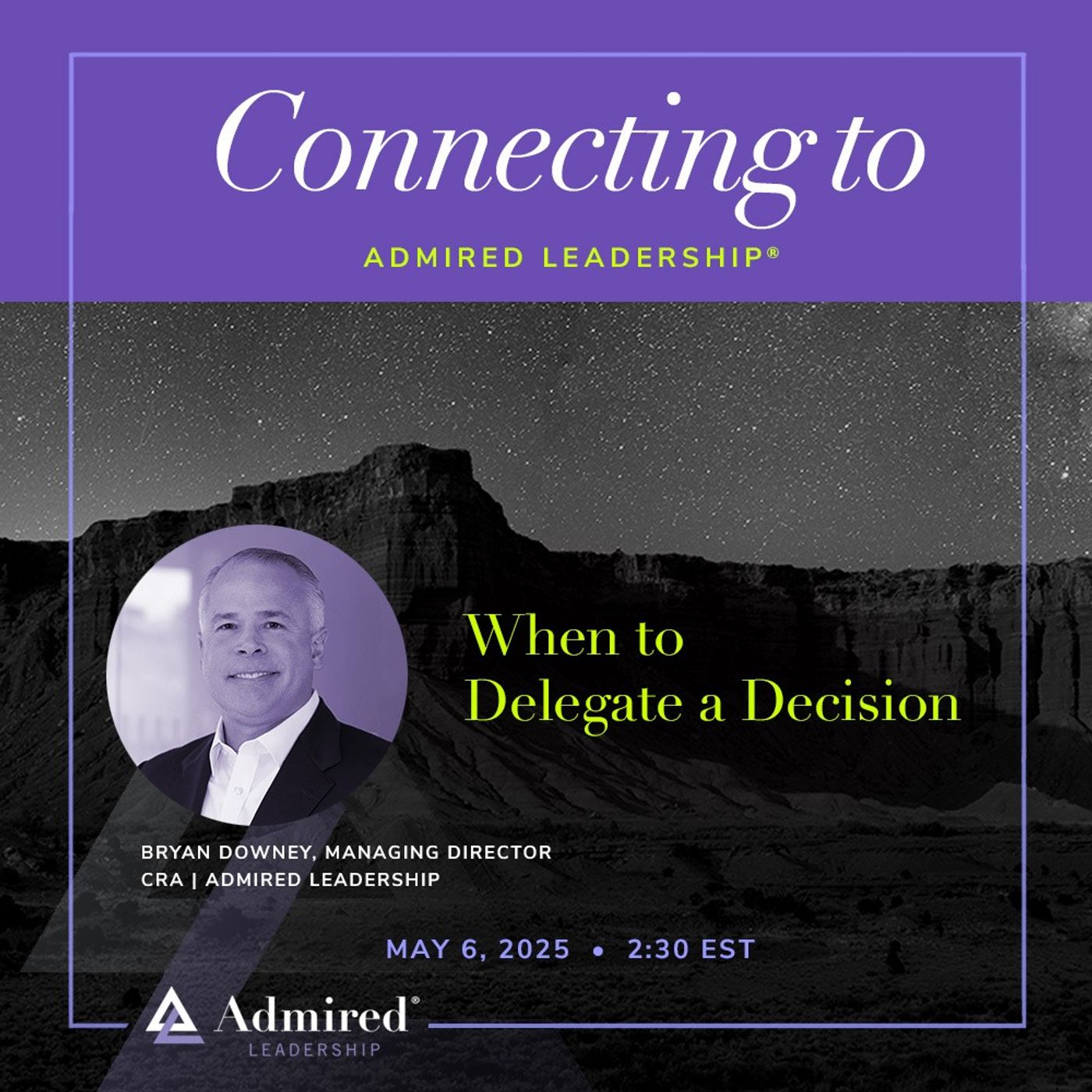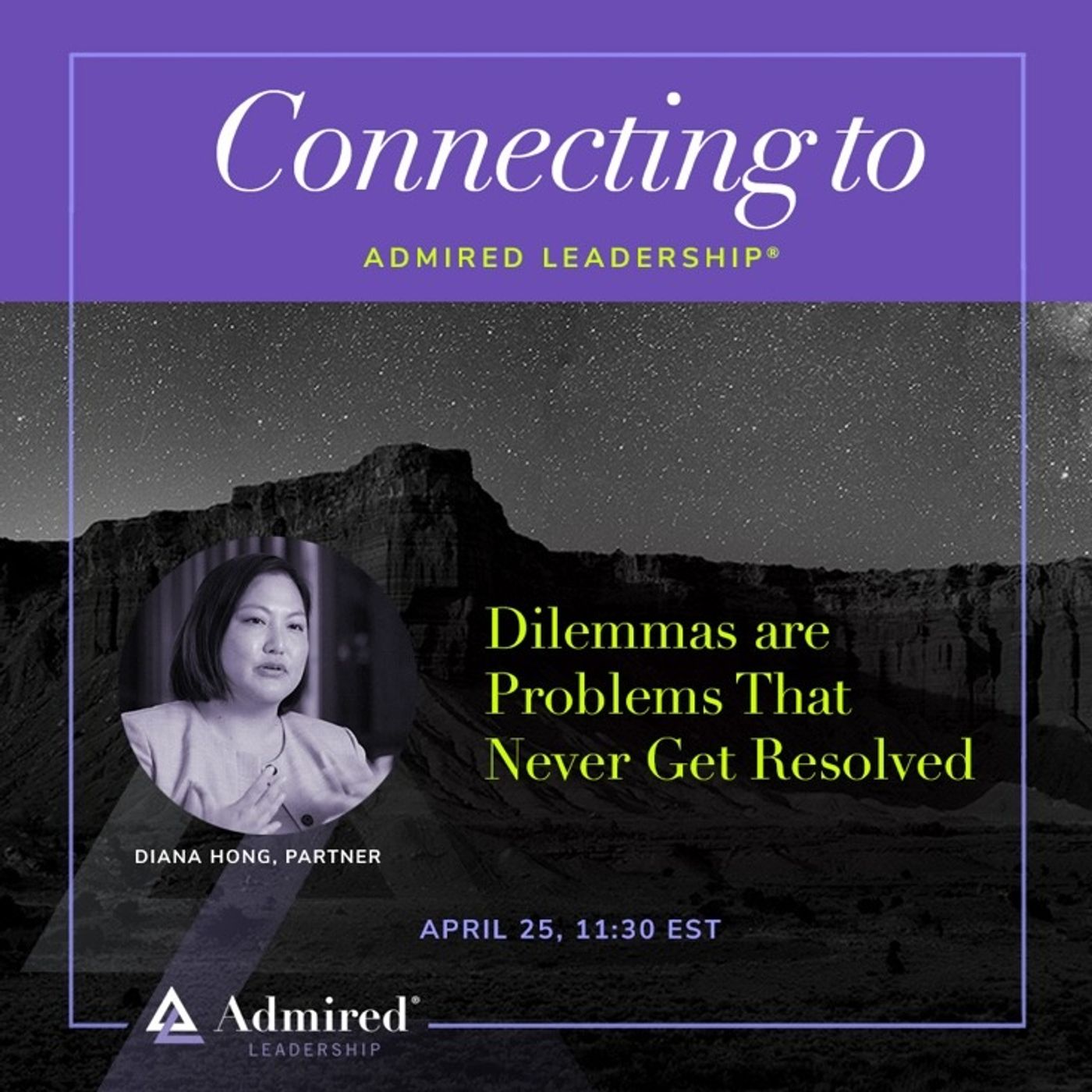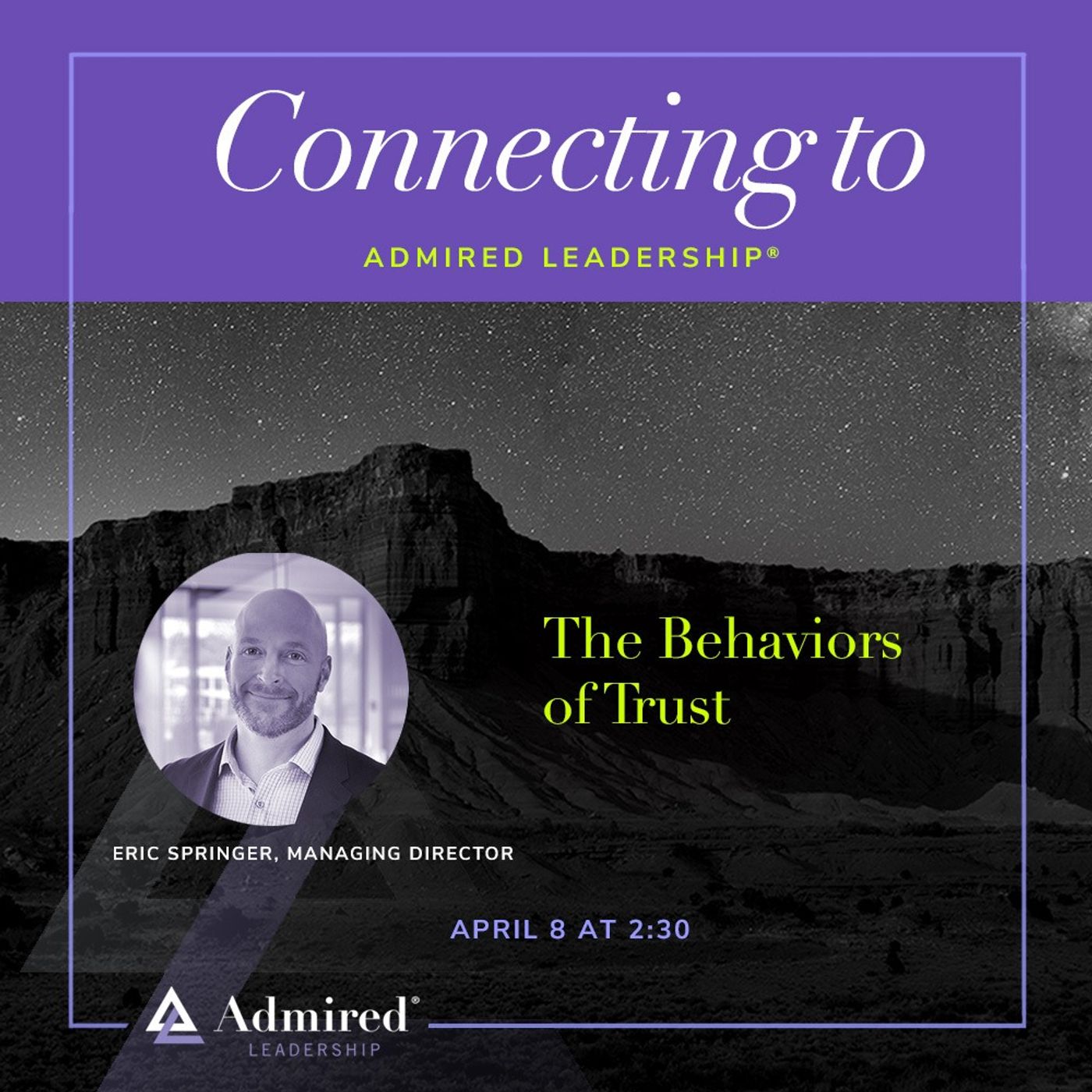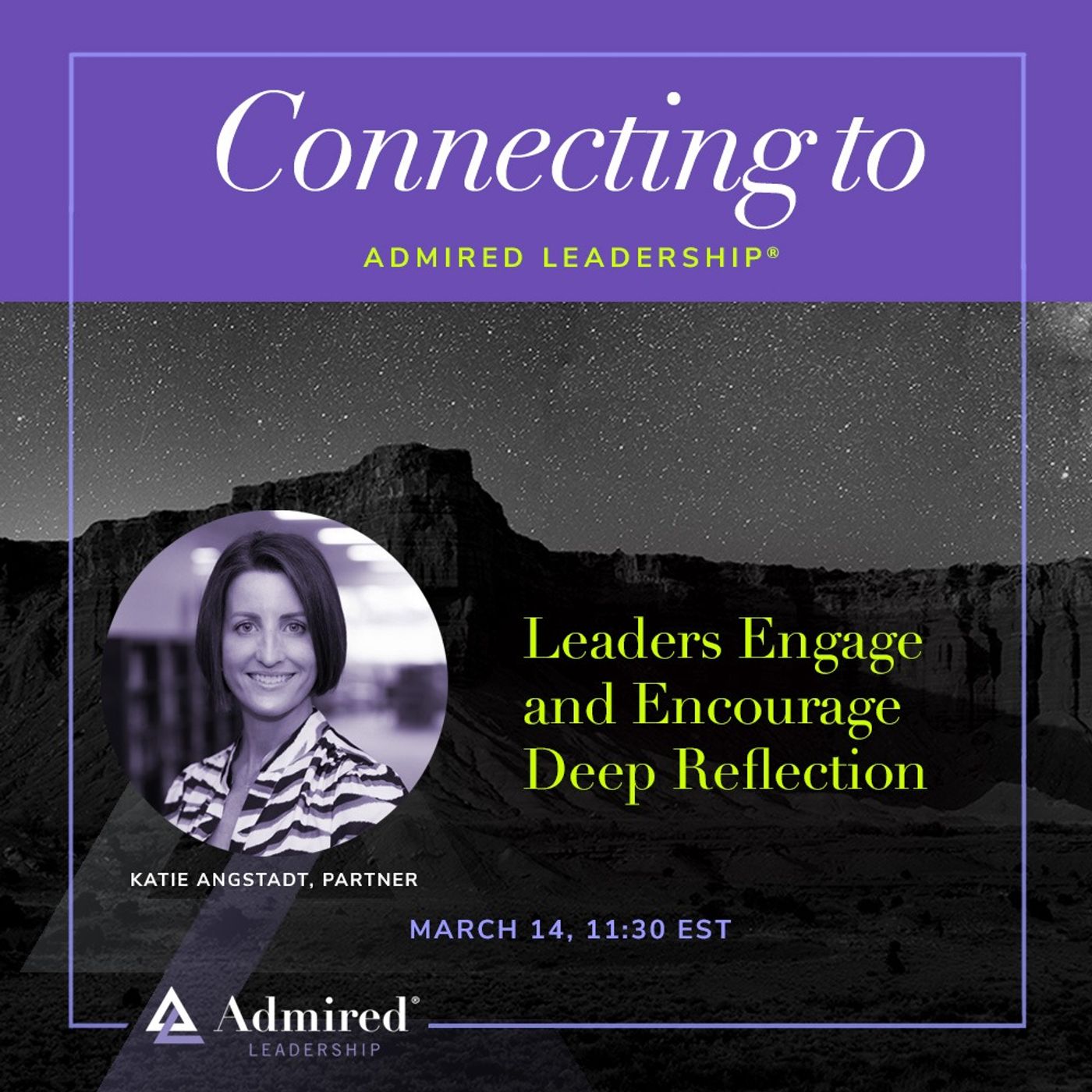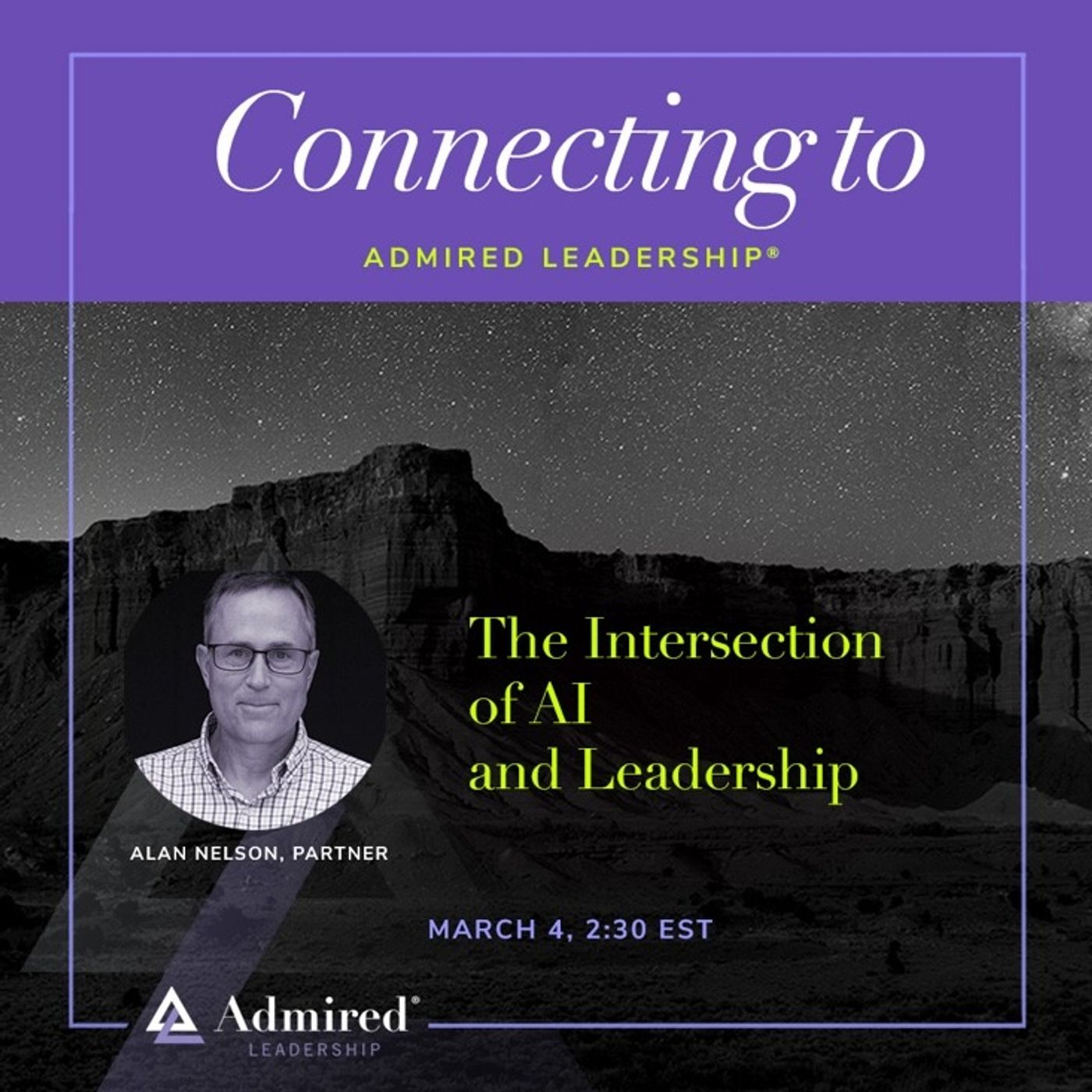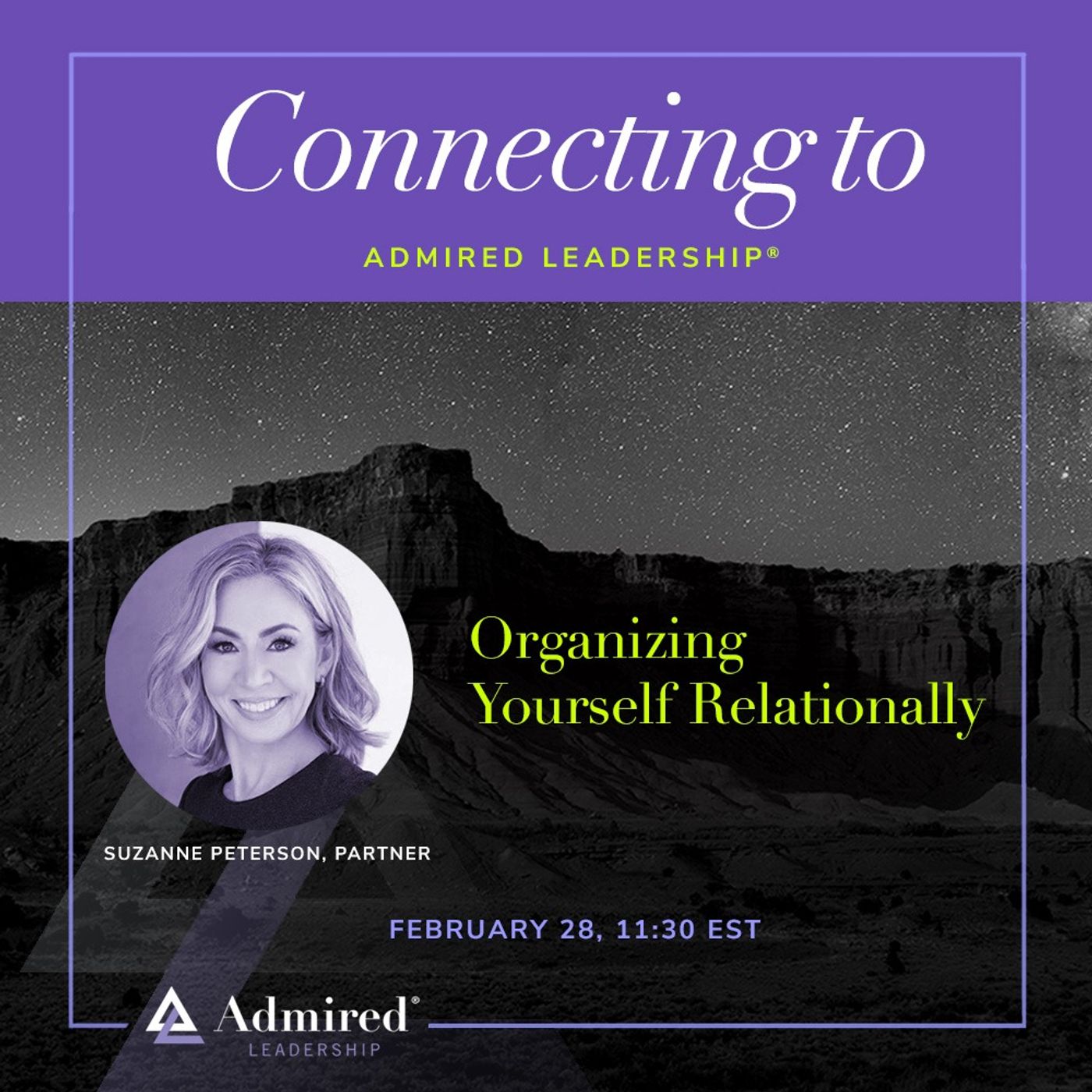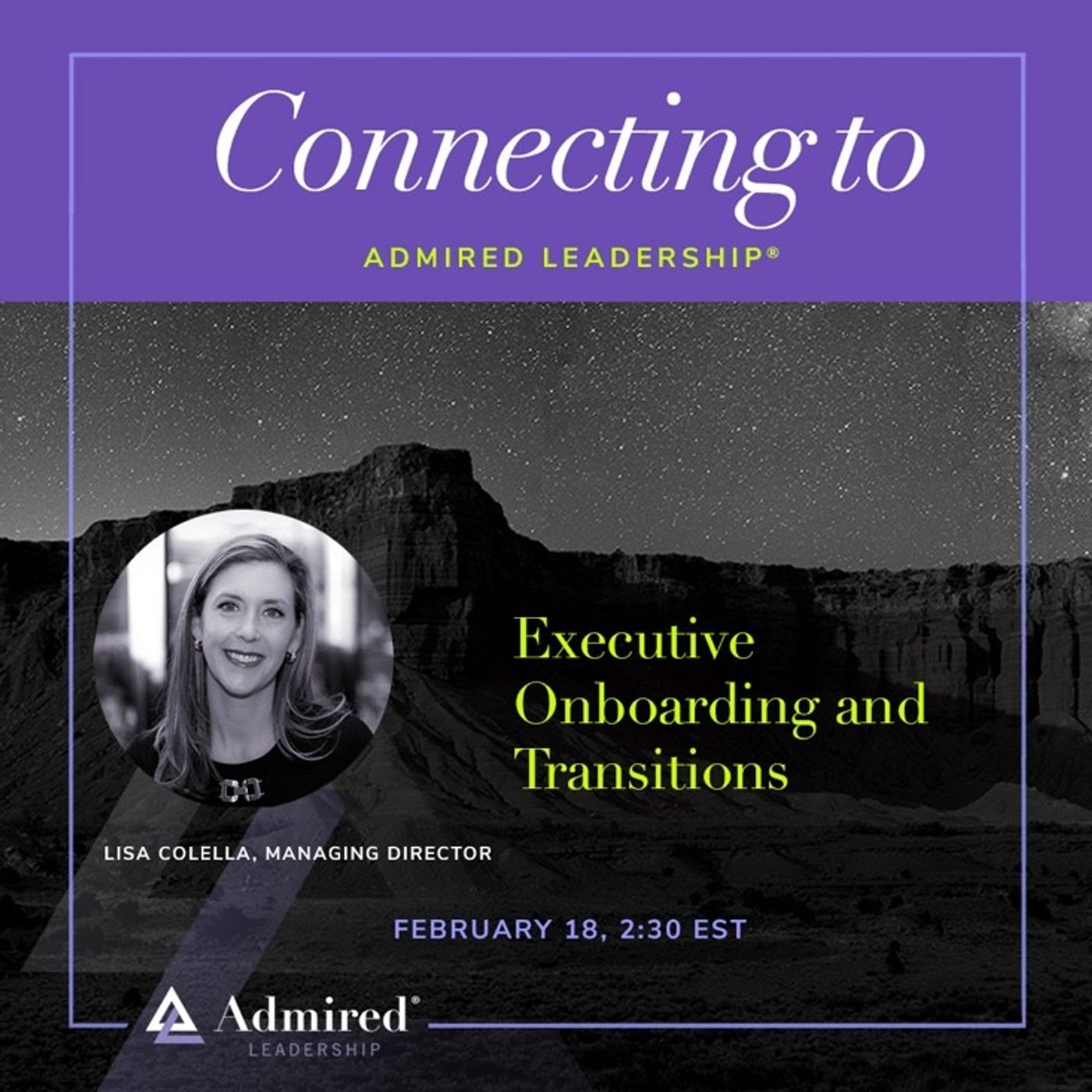Discover Connecting to Admired Leadership
Connecting to Admired Leadership

Connecting to Admired Leadership
Author: Admired Leadership
Subscribed: 2Played: 26Subscribe
Share
Description
Twice a month, we take 30 minutes to connect leaders to Admired Leadership® content and our Admired Leadership® coaches.
These sessions are specifically tailored for leaders who are craving universal, simple and actionable leadership content. Participants will leave the session with an understanding of Admired Leadership’s behavioral approach as well as valuable insights to implement immediately.
These sessions are specifically tailored for leaders who are craving universal, simple and actionable leadership content. Participants will leave the session with an understanding of Admired Leadership’s behavioral approach as well as valuable insights to implement immediately.
30 Episodes
Reverse
Register to be part of future conversations in real time hereOr schedule a time to talk directly to our team here Key HighlightsGood leaders don't act aggressively on purpose - aggression is perceived as a personal or professional threat and damages loyalty, even though it may produce short-term compliance when you have status and powerTurn up respect, not down aggression - instead of trying to suppress forceful behaviors, focus on maximizing respect in conversations, which naturally prevents interrupting, yelling, intimidation, and other behaviors people interpret as aggressiveAssertiveness requires advocacy with respect - you can be direct, passionate, persistent, and forceful about what you believe while still being hugely respectful to others; these aren't mutually exclusive qualitiesExit aggressive conversations in the moment - when someone is being aggressive, that's not the time for productive confrontation; leave the room, lower your energy when theirs goes up, and address the relationship pattern later when emotions aren't running highApologies require behavior change - if you've been aggressive, saying sorry matters but real relational repair requires changing your pattern of interaction going forward, not just acknowledging what happenedNotable Quotes"Do good leaders ever act aggressively? Not on purpose. Aggressiveness is almost always perceived as a personal or professional threat by other people. Good leaders don't try to threaten people.""The problem with being aggressive is it tends to work. It has efficacy, especially if you have status. But in the long term, it's not, because anybody who's got real talent is going to have too much self-respect to keep working for me.""If you're trying to treat people with the maximum level of respect, it would be very difficult for you to engage in behaviors that are seen as aggressive.""When somebody's aggressive, and you challenge them, I guarantee you they will become more aggressive. So timing matters.""Just because someone is direct does not mean that they are aggressive. It means they're direct. There are entire cultures that are highly direct, like Holland, like Israel.""Mending the relationship is really about changing the pattern of interaction. You have to change how you talk to people. You have to bring more respect to those conversations."Featured SpeakersAlan Nelson is Co-Managing Partner & Executive Coach at CRA | Admired Leadership with over three decades of experience advising senior leaders through major mergers, restructurings, crises, and high-stakes leadership transitions. Known for his direct yet respectful coaching style, Alan has been in the room when leaders have had to make incredibly difficult decisions under enormous pressure and specializes in helping leaders be forceful and firm without damaging relationships or credibility.Wes Bender serves as a facilitator and thought leadership coordinator at CRA | Admired Leadership, helping to connect practical leadership insights with real-world application through webinars and educational content.Resources MentionedField Note: "Small Signs of Respect Tell People You Honor Relationships"
Register to be part of future conversations in real time hereOr schedule a time to talk directly to our team here Key HighlightsCredibility has two dimensions: Competence (your ability to do the work) gets presumed as you become more senior, while character (how people perceive your integrity) requires intentional demonstration through small signs of respectConsistency matters more than grand gestures: How you do one thing is how you do everything - showing respect to the front desk greeter the same way you show it to senior leaders reveals your authentic characterCommon unintentional disrespect signals: Canceling meetings last minute, not responding to emails timely, interrupting people, not greeting colleagues in hallways, and being distracted during conversations all compound over timeListen to understand, not to reply: Write down what you want to say instead of interrupting, pause 3 seconds before responding, and practice saying "tell me more" to demonstrate genuine listeningVirtual respect requires extra effort: Be intentional about camera usage, avoid eating on camera when others aren't, schedule meetings that accommodate different time zones, and work harder to convey respect with limited contextNotable Quotes"Respect is about wanting our teams to hold us in high regard, to believe we have value, and to trust our judgment - and it's not just about our teams, it's about people we need to influence down, across, and up.""How you do one thing is how you do everything. That's the way people judge you and the lens through which they evaluate who you are.""There's a tendency to be more respectful up to people who are more senior, and less respectful when leading across or down. But you should be showing signs of respect regardless of hierarchy.""As leaders, our time is highly symbolic of what's important to us. If we're being intentional about being present and listening, we're saying that you matter and you're important to me.""Sometimes increasing your urgency around response can really increase your ability to be seen as someone who's respectful and values other people."Featured SpeakersKatie Angstadt is an Executive Coach & Partner at CRA | Admired Leadership, known for making people feel like they're the only person in the room through her warm, thoughtful, and fully present approach. With extensive experience coaching senior leaders on credibility and relationship building, she specializes in helping leaders demonstrate character through consistent, authentic actions. A triathlon participant who practices the respect principles she teaches.Wes Bender serves as a facilitator and thought leadership coordinator at CRA | Admired Leadership, helping to connect practical leadership insights with real-world application through webinars and educational content. Fresh off facilitating a successful on-location event in Boston.Resources MentionedField Note: "Small Signs of Respect Tell People You Honor Relationships"
Register to be part of future conversations in real time hereOr schedule a time to talk directly to our team here Key HighlightsOpinion vs. perspective defined: Opinions are immediate reactions grounded in feelings and bias that often shut down conversations; perspectives are broader views based on data that raise questions and open up thinkingWhen opinions are appropriate: Three situations call for direct opinions - time-sensitive decisions, when someone explicitly asks for your judgment, and very high-stakes scenarios where deliberation isn't feasibleFour question frameworks for offering perspective: "What lens are we using?", "If we thought of this as an X problem instead of Y, how would we approach it?", "What would [person/role] say that we're not seeing?", and "What are we optimizing for?"Acknowledge your bias to counter it: Either admit your bias upfront and ask others for different perspectives, or actively seek people with different biases and ask "What would be true if I abandoned my bias?"Perspectives early, opinions at decision time: When you have the benefit of time, gather perspectives through questions; when it's "go time" and a decision must be made, that's when opinions are neededNotable Quotes"An opinion is your immediate reaction, grounded in feelings and bias. A perspective is a broader view based on data that raises more questions than answers.""Opinions often shut down conversations, especially if you're a leader. If you have a really strong opinion, everyone goes 'well, I'm not going to bother to weigh in.'""When you have the beauty of time, let's get perspectives. If it's go time - high stakes, decision needed - that's where opinions come in.""Before you assert an opinion, ask yourself: What am I assuming here? The problem may be misidentified.""If you always offer opinions, your team gets lazy - they just wait for you to give the answer. If you offer perspectives, they learn to understand trade-offs and ask better questions."Featured SpeakersDr. Suzanne Peterson is a Partner at CRA | Admired Leadership with over 25 years of experience coaching Fortune 500 executives. Known for helping leaders shift from "here's what I think" to "here's what you might not be seeing," she specializes in expanding how leaders see their challenges and opportunities. Her work focuses on high-performance coaching with teams already operating at top levels who want to get 10-20% better.Wes Bender serves as a facilitator and thought leadership coordinator at CRA | Admired Leadership, helping to connect practical leadership insights with real-world application through webinars and educational content. A proud Tennessee Volunteers fan navigating parenting teenagers.Resources MentionedField Note: "Leaders Give Perspective More Than They Give Opinions"
Register to be part of future conversations in real time hereOr schedule a time to talk directly to our team here Key HighlightsThe praise-stingy paradox: Leaders with extremely high standards tend to withhold feedback because excellence is simply expected - but this silence causes people to presume negative, making regular feedback essential even for high performersThe 2x2 feedback framework: Effective feedback balances valence (how it's received - positive or negative) with utility (how actionable it is), aiming for the "Holy Grail" of positive reception with high usefulness while avoiding the "insult bucket"Be specific when seeking feedback: Never ask "Give me some feedback" - instead, identify one specific area you're working on and ask people who see you in action to tell you when they observe you doing it well or poorlyLeading without domain expertise: When leading people whose expertise exceeds your own, focus on developmental experiences, removing roadblocks, and creating high-performing team dynamics rather than trying to match their technical knowledgeThe 1-10 framework for actionable feedback: Ask "On a scale of 1-10, how am I doing as your [role]?" then follow with "What one thing could I do to get from a [X] to a [X+1]?" to generate specific, actionable insightsNotable Quotes"Leaders who demand the best from others tend to be praise stingy because that desire for excellence is so high. But when they do give feedback, it lands with real power and meaning.""The Holy Grail is feedback that's received in a positive way and also has usefulness - it's actionable, I can do something with it in the future.""How you do anything is how you do everything. If you have blind spots at work, they're likely showing up at home or in the community too.""Leadership is a contact sport. There is feedback all around you if you're open to it - in how people react to your presentations, in the questions they ask, in their behavior.""The best teams are more player-led than leader-led. Your job isn't to know their role better than they do - it's to create clarity around goals, remove obstacles, and point to the North Star."Featured SpeakersJohn Cook is a Partner & Executive Coach at CRA | Admired Leadership, specializing in executive coaching and leadership development. A father of four and avid fly fisherman, he works extensively with C-suite leaders while also developing emerging coaches within the firm. Known for his constant pursuit of feedback and commitment to continuous improvement, he brings practical frameworks for talent development and team performance.Wes Bender serves as a facilitator and thought leadership coordinator at CRA | Admired Leadership, helping to connect practical leadership insights with real-world application through webinars and educational content. A proud Tennessee Volunteers fan from Knoxville.Resources MentionedField Note: "In the Absence of Feedback, the Most Experienced People Presume the Negative" (inspired by Pat Summitt)
Register to be part of future conversations in real time hereOr schedule a time to talk directly to our team here Key HighlightsReframe speed vs. quality: Leadership strength isn't about making fast decisions - it's about making quality decisions informed by the right people, aligned with values, and considering second-order consequencesASAP vs. ALAP framework: Distinguish between decisions that must be made "as soon as possible" (low consequences or time-sensitive) versus "as late as possible" (complex decisions where maintaining optionality reveals better options over time)The dangers of binary thinking: Black-and-white decision-making leads to missing facts, flip-flopping on decisions later, and ignoring your own judgment in favor of perceived group wisdomTrain yourself to ask questions first: Instead of immediately answering "yes" or "no" to requests, develop the habit of responding with questions like "What needs to be true for this to happen?" to create space for better thinkingLadder of autonomy for teams: Help staff understand when to seek input (political decisions, precedent-setting, budget thresholds) versus when they have autonomy to act, preventing the "checkbox mentality" while ensuring quality decisionsNotable Quotes"We confuse strength of leadership with decisiveness, and really decisiveness meaning speed of decision-making. We think we need to know the right answer and say it quickly, and if we can't, it makes us look weak.""When people say 'I don't have time to think in the gray,' my reaction is you don't have time not to, because you're going to end up going back on decisions you made.""Train yourself to never answer a definitive question at the beginning, and start asking questions. If somebody says 'Do you think we should do this?' do not say yes or no.""Quality decisions often come down to: Have you gotten the right people to weigh in on it? Options will reveal themselves over time if you're not trying to be fast and decisive.""Values-driven leaders are often the most admired leaders. Spend time thinking about how you can be a values-driven leader too."Featured SpeakersCarolynne Thomas is a Partner & Executive Coach at CRA | Admired Leadership, known for her expertise in organizational culture transformation and strategic decision-making. With extensive experience helping leadership teams articulate and implement cultural change, she exemplifies the ability to operate in gray areas while maintaining clarity on values and outcomes. Her work focuses on creating experiences that help leaders and teams align around shared objectives.Wes Bender serves as a facilitator and thought leadership coordinator at CRA | Admired Leadership, helping to connect practical leadership insights with real-world application through webinars and educational content.Resources MentionedField Note: "On Thinking Gray"
Register to be part of future conversations in real time hereOr schedule a time to talk directly to our team here Key HighlightsCommon goals vs. common ground: While we naturally gravitate toward people who share our interests or backgrounds, focusing on what we're building together creates stronger, more sustainable relationships than waiting for personality clicksEffort matters more than ease: The relationships that required the most work to build often become the deepest and most trusted - don't assume that natural or easy connections are automatically betterIncremental trust building: When relationships are damaged, create small, shared goals with quick wins rather than attempting one big conversation - trust builds through repeated small promises kept, not dramatic gesturesOrganizational impact of leader relationships: When leaders have tension, it forces team members to pick sides and creates psychological unsafety - people have to watch what they say and consider political repercussionsBuilding collaboration muscles: Start with deliberately created shared projects, even if they're not mandated from above, to develop habits of communication and accountability that transfer to future collaborationsNotable Quotes"If you focus less on commonality and more on common goals - what are we building that we can share together - that ends up actually unifying us more over time than waiting for some magical click to happen.""Effort matters, and that's actually completely controllable, because we can control the amount of effort we put into a relationship. It doesn't have to be this mystical personality match.""Trust happens incrementally. Trust doesn't happen in big, dramatic swoops - it's small, incremental promises that were made, kept, and followed through.""When leaders have tension, we're subtly telling people around us that you gotta pick a side. That makes people feel less safe because now they have to watch what they say.""Just by the fact of signing up to say 'I'm committing to doing this, it's not natural, it's not easy, but I'm committing' - that's what actually makes the relationship start gelling together."Featured SpeakersDiana Hong is a Partner & Executive Coach at CRA | Admired Leadership, specializing in organizational change and relationship dynamics. With extensive experience coaching senior leaders through complex interpersonal challenges, she brings practical insights on building trust and collaboration in high-stakes environments. Her approach emphasizes actionable strategies over theoretical frameworks.Wes Bender serves as a facilitator and thought leadership coordinator at CRA | Admired Leadership, helping to connect practical leadership insights with real-world application through webinars and educational content.Resources MentionedField Note on finding common ground vs. common goals
Register to be part of future conversations in real time hereOr schedule a time to talk directly to our team here Key HighlightsThe Clarity Index reveals five essential topics for regular communication: strategy, culture, functional strategy, role clarity, and employee value proposition (why work here vs. elsewhere) - lack of clarity in these areas directly impacts engagement and decision-making speedConnect everything back to strategy: Don't just communicate strategy once in January - every decision, change, or new initiative should be explicitly connected back to your organizational strategy throughout the yearCultural clarity requires specificity: Values like "excellence" or "trust" are meaningless without behavioral examples - use promotions, hiring decisions, and daily interactions to demonstrate what these values actually look like in practiceConditions of accountability drive clarity: Set clear expectations (format, detail level, deadlines), provide proper resources (templates, examples of excellence), give appropriate autonomy, and define positive/negative consequencesTailor detail to audience: With senior leaders, be brief, brilliant, and be gone - they'll ask for more if needed. With teams, mix formats using pre-reads, focused meetings, and detailed follow-ups rather than cramming everything into one communicationNotable Quotes"Message sent is rarely message received. People are looking at your actions, decisions, and interactions to see what's really true.""When senior leaders want three things from you: be brief, be brilliant, and be gone. If they want more detail, they'll ask.""Your strategy can only be clear if there aren't detractors from it. You have to proactively look for where skeptics will roll their eyes.""Do a little bit more work up front to create clarity for better results the first time, rather than going back and forth on details later.""Before important communications, ask yourself: What is the one thing I want people to take away from this?""Culture itself is intangible - we have to tie cultural values into things we're already communicating about, like promotions and daily interactions."Featured SpeakersSierra Holland is a Managing Director in CRA | Admired Leadership's Strategic Communications practice, specializing in helping leaders become better communicators for their teams. With expertise in organizational communication strategy and the proprietary Clarity Index research, she focuses on creating communication experiences that drive engagement and decision-making effectiveness. Known for her sharp facilitation skills and curiosity-driven approach to client work.Wes Bender serves as a facilitator and thought leadership coordinator at CRA | Admired Leadership, helping to connect practical leadership insights with real-world application through webinars and educational content.Resources MentionedField Note - The Signs a Team is Waiting for a Decision or Strategy
Register to be part of future conversations in real time hereOr schedule a time to talk directly to our team here Key HighlightsValues vs. virtues distinction: Values should be specific, actionable, and behavioral (like "I include every voice in meetings") rather than abstract virtues (like "inclusion") that don't provide clear guidance for decision-makingThe admiration approach: Instead of asking "What are your values?" ask "Who do you admire and what specifically do you admire about them?" This cuts through the noise of aspirational lists and reveals authentic prioritiesFocus on attributes, not whole persons: Rather than putting leaders on pedestals, identify specific behaviors or qualities you admire - collecting "points of reference" from multiple people to build your own leadership approachMaking values actionable: Test your values by examining where they show up in daily decisions - who you hire, how you spend time, what you fund, how you give feedback, and who gets airtime in meetingsOrganizational vs. individual values: In team settings, use inclusive language ("What do we value?") and let organizational strategy be the equalizer when individual values conflictNotable Quotes"Values should be specific and actionable and behavioral. Virtues are sort of that aspirational list of descriptors, but what we want to strive for are practical manifestations that show up in how we lead day-to-day.""It's really hard to put that lens on yourself and say, here's everything that I value. But a great indicator is discerning what people value or admire in others as a starting point.""I think about it as collecting points of reference. Pretty much everybody's got something you can admire - not a person as much as pieces and parts of lots of people.""The great equalizer is the organizational vision and strategy. When values are in tension, the question shouldn't be personal preference as much as what does the organization need.""If I've said this is important to me, would somebody else be able to observe that and say, yeah, that's important to you?"Featured SpeakersBen Stringfellow is an Executive Coach and Partner at CRA | Admired Leadership, known for his expertise in organizational communication and strategic leadership development. Despite being one of the firm's busiest members, he's recognized for always making time to support colleagues and clients with thoughtful guidance and practical insights.Mallory Stacey is an Executive Coach at CRA | Admired Leadership, filling in as host for this session. She brings expertise in leadership coaching and team development, with a focus on helping leaders translate abstract concepts into actionable behaviors.Resources MentionedField Note: Your Admiration for Others Reveals Your Core Values
Register to be part of future conversations in real time hereOr schedule a time to talk directly to our team here Key HighlightsTwo contrasting leadership stories: One showing how a senior admiral responded with grace when David made a career-threatening mistake with VHS tapes during a high-stakes presentation, and another where David's own reactive response to a difficult colleague cost him $50,000 in bonus and a promotion opportunityMoving beyond conventional wisdom: Traditional advice like "count to 10" treats symptoms rather than root causes - the best leaders develop consistent behaviors that create natural space between triggers and responsesThe power of inquiry over immediate answers: Develop the habit of asking 1-3 questions before responding, using phrases like "Tell me more about that" or "Say more about why you're feeling that way" to create thinking spaceThrowing problems back strategically: When someone brings you an emotionally charged issue, ask them for more context about how and why they feel that way - this gives you time to reflect while helping them process their emotionsJudicious shows of emotion can be motivational: Sometimes a look or controlled display of frustration can be effective feedback, but only when built on a foundation of clear expectations and strong relationshipsNotable Quotes"Leadership is what you do. It's how people react to you that's most important. Everybody else that engages with us is grading our papers based on our engagement.""Our goal isn't really to eliminate our emotional reactions because we are first human beings. What we want to do is develop consistent behaviors that create a space between the trigger and the response.""What we're not trying to do is automatically equal an answer in the immediate. What we're trying to do is become an excellent problem solver.""You owe them a response, not necessarily an answer to their question. Think about the difference in the frame with those two.""If you respond smartly, you can diffuse or derail a negative situation versus reacting immediately and viscerally and creating a kerfuffle."Resources MentionedField Note: "Learn to Respond Instead of React"
Register to be part of future conversations in real time hereOr schedule a time to talk directly to our team here Key HighlightsLeadership resides in behavior, not personality: Excellence in any domain comes from what you do, not who you are - leadership is a composite of choices, routines, and actions rather than innate traits or psychological dispositionsSelf-assessments can create self-limiting beliefs: Tools like Myers-Briggs, DISC, and others risk becoming excuses for behavior rather than catalysts for growth, leading people to say "this is just who I am" instead of "who do I want to become?"Focus on commonalities over differences: Great teams function because of what they share - values, standards, expectations - rather than constantly highlighting how members are different from each otherBetter alternatives for building awareness: Use direct feedback, smart questions, and honest conversations rather than formal assessments - ask "What's it like to be on the receiving end of me?" or "How do I get to the next number on a 1-10 scale?"The Venn diagram approach to development: Focus where two circles intersect - things you're not good at AND things others need you to be great at, discovered through conversation rather than assessmentNotable Quotes"Leadership resides in behavior. Who you are as a leader is a composite, a stained glass window of lots of things that you do or don't do.""I'm much more interested in teams about what we have in common than what we have in difference. Great teams don't function because they all talk about each other's differences all the time.""What a shame that I know what your DISC profile is, but I don't know why you asked your wife to marry you or where you asked her to marry you.""Don't work on what you want to get better at - work on what people need from you most that you're not good at.""The question is, who do you want to be? Not who are you today. I think that's the wrong question.""My job is to hold up a mirror that other people won't hold."Resources MentionedField Note: "When Self-Assessment Harms Your Personal Development"
Register to be part of future conversations in real time hereOr schedule a time to talk directly to our team here Key HighlightsThe four-ingredient framework for compelling visions: Strong purpose (why do we exist?), vivid imagery (people can see and imagine the destination), credibility (prevents eye rolls), and cultural resonance (uses language that connects with your specific team)Strategic planning trap revealed: Most organizations develop strategy first, then try to communicate it - but once language gets "baked" into planning documents, it becomes nearly impossible to change the clunky management-speakThe eye roll test: Before launching your vision, identify every policy, practice, or behavior that contradicts what you're saying - either eliminate them publicly or explain why you can't change them yetLeadership fatigue phenomenon: Leaders spend 6 months developing their vision and strategy, then get bored with it just as they need to start communicating it - "the song is in their head but not in anyone else's head yet"Making visions actionable: Your vision must be something your average team member can actually do something about in their daily work - if they can't see how they personally contribute, you won't create intrinsic motivationNotable Quotes"You gotta keep the main thing the main thing" - everything you communicate should connect back to your vision and strategy"People will believe what you do before what you say" - contradictory actions will undermine even the most compelling vision"Everyone has a plan till they get punched in the mouth" - Mike Tyson's wisdom on why 5-10 year strategic plans may be foolhardy in today's world"Great place for great people to do great work" - a vision so memorable that an employee could recite it perfectly 10 years later at a new organization"You need to look for signals that you're not serious about your vision and strategy" - identifying and eliminating contradictions is critical for credibilityFeatured SpeakerCarolynne Thomas is an Executive Coach and Partner at CRA | Admired Leadership, specializing in strategic organizational communication and leadership coaching. She spends her time helping organizations mobilize around vision and strategy, working across both the leadership and strategic communications practices of the firm.Resources MentionedField Note: "The Ingredients of a Compelling Vision"Four-question organizational messaging framework
Register to be part of future conversations in real time hereOr schedule a time to talk directly to our team here Key HighlightsRedefining high potential: High potential does not necessarily equal ready to lead - the skills that make someone excellent in their current role don't automatically translate to leadership capabilityTwo critical talent indicators revealed: - "Excellence Someplace Else": Look for people who've achieved excellence in any domain (sports, music, academics) as they understand the work ethic and commitment required to master skills - Deep Self-Awareness: True self-awareness means understanding not just your weaknesses, but how those weaknesses affect other people around youStrategic hiring approach: Don't overweight background and track record since you can't determine if success came from the platform, team, or market timing - focus on talent indicators insteadTalent development principles: Leaders must get out of the way of talented people, remove obstacles, and focus on continuous feedback rather than annual reviewsMaking it systematic: Talent assessment, nurturing, and development should be a standing agenda item with quarterly conversations, not an annual afterthoughtNotable Quotes"High potential does not necessarily equal ready to lead, or even fit to lead, for that matter.""Hiring and managing talent is one of the most strategic and symbolic acts you can do as a leader.""True talent finds a way to win in good times and bad, high tide, low tide. They tend to operate well in different contexts, and even different organizations.""When's the last time someone misperceived you? And why? Because true self-awareness is understanding weaknesses and also knowing how that rubs off on other people.""If they're truly stars, you got to provide direction and guidance... but then get out of the way. You're never going to know their job as well as they know their job.""If talent is the most important thing, then we need to make time for it... it needs to be a standing agenda item."Featured SpeakerJohn Cook is an Executive Coach & Partner at CRA | Admired Leadership, specializing in talent assessment and leadership development. As a father of four and avid fly fisherman, he brings both professional expertise and personal perspective to helping senior leaders identify and develop talent within their organizations.Resources MentionedField Note: "High Potential for What? Exactly"Nine proprietary talent indicators framework10-minute coaching conversations with Admired Leadership coaches
Register to be part of future conversations in real time hereOr schedule a time to talk directly to our team here Key HighlightsDistinguishing between three key concepts: - Leadership style: How you express yourself verbally, non-verbally, and contextually - Executive presence: The energy you project when entering a room or engaging with others - Gravitas: Verbal precision and fluidity that makes others hang on your every wordUnderstanding style as developable: - Like a singing voice, everyone has a natural range they can expand - Most people can improve their style by 20-30% while remaining authentic - Focus on small changes in verbal, non-verbal, or contextual elementsPractical development strategies: - Collect and intentionally use more intense vocabulary - Increase lexical diversity to avoid overused words and phrases - Adjust your approach based on audience (more attractive markers with junior staff, more power markers with senior executives) - Start with power markers and then back off rather than starting too attractiveCommon coaching scenarios: - The "bull in a china shop" who needs to add more attractive markers - Leaders who struggle when changing contexts or industries - Those who need to balance being powerful enough to be listened to while attractive enough to be followedNotable Quotes"Style is a set of behaviors or habits, and it's more about what you do than who you are on the inside. Therefore, everybody can flex their style and they can do so authentically.""Style is the largest contaminator of your competence. No matter how good you are, negative style can take away from your competence.""To have real executive presence would be to be powerful enough to be listened to, but have enough attractive markers to be followed and for people to want to be around you.""Much easier to start a little bit more powerful and then back off versus coming in more attractive and trying to go power from there.""When you enter any situation, you have to ask, how do I want to be seen?"Featured SpeakersDr. Suzanne Peterson is a Partner at CRA | Admired Leadership and a leading expert on leadership style, executive presence, and gravitas. She specializes in helping leaders understand how their style impacts their effectiveness and how to make strategic adjustments to expand their range.Mallory Stacey is a Managing Director at CRA | Admired Leadership who partners with Suzanne on style code coaching and programming. She brings practical experience having transformed her own style from management consulting to leadership coaching.Resources MentionedPrevious webinar recording on leadership styleStyle Code coaching programPower markers vs. attractive markers framework
Register to be part of future conversations in real time hereOr schedule a time to talk directly to our team here Key HighlightsUnderstanding delegation as a strategic decision: - Delegation is itself a decision, not an abdication of leadership - Effective delegation serves as a performance multiplier for organizations - The best delegators view it as a developmental tool, not just time managementWhat leaders should never delegate: - Strategy and strategic direction - Talent decisions for direct reports - Material legal or regulatory matters - Anything related to organizational character and values - Delivering bad newsFramework for effective delegation: - Consider the strategic importance of the decision - Assess the urgency and reversibility of the decision - Evaluate team member capabilities and experience - Identify learning opportunities for team developmentFollow-up cadence after delegation: - Adjust based on the importance and urgency of the decision - Consider the experience level of the person you're delegating to - Focus on process over outcomes when evaluating results - Create psychological safety when mistakes happenNotable Quotes"Deciding to delegate a decision is still a decision. You're not giving up decisiveness by delegating.""You're robbing yourself of free time to think strategically, robbing yourself of the force multiplier of other perspectives, and robbing individuals of developmental opportunities by not delegating.""As you get further in your career, you really start to have more of a focus on what your legacy is going to be, and your legacy is going to be the people.""Don't focus on the outcome. Focus on the process and how we got to this point.""The number one thing you never want to do to your leaders is give them work to do. You want to be taking work off their desk."Featured SpeakerBryan Downey is an Executive Coach and Managing Director at CRA | Admired Leadership with over 20 years of experience as a corporate executive, including roles as CEO and President in both public and private organizations. He specializes in helping leaders develop their decision-making capabilities and maximize their impact through effective delegation and team development.Resources MentionedField Note: "When to Delegate a Decision"Jeff Bezos's approach to delegation using "one-way door" vs. "two-way door" decisionsStyle Code Webinar Series on executive presenceAlex - Admired Leadership's AI executive coach
Register to be part of future conversations in real time hereOr schedule a time to talk directly to our team here Key HighlightsDistinguishing problems from dilemmas: - Problems are solvable issues where you have control or influence - Dilemmas are situations largely outside your control that must be managed - Recognizing the difference changes your approach and energy allocationHallmarks of a dilemma: - It's 90-100% out of your control - Attempting to solve it often makes things worse - It has a "long tail" with cascading effects - When you zoom out, you see it has many tentacles across the organizationEffective approaches to dilemmas: - Reframe as "not yet" rather than "never" - Focus on what you can control rather than what you can't - Document potential solutions for when circumstances change - Choose effectiveness over being rightLeadership communication strategies: - Help teams recognize dilemmas without becoming demotivated - Validate past work when implementing change - Involve people in data collection and analysis - Redirect energy toward solvable problemsNotable Quotes"Do you want to be right or do you want to be effective? Pick one.""Just because the answer is 'not yet' doesn't mean that it's 'never'.""You can't just only talk about the new legacy going forward because that erases what everyone else has done so far.""Think of yourself as a precious resource here... focus on the places where you're going to get the biggest return on your investment.""The measure of success is nobody's talking about it anymore."Featured SpeakerDiana Hong is a Partner and Executive Coach at CRA | Admired Leadership with over 20 years of experience advising on strategic communication, change management, executive visibility, and stakeholder relationships. She specializes in coaching leaders and teams through complex organizational challenges and has worked with clients across numerous industries. Diana is known for her practical approach to leadership development and her ability to help leaders distinguish between problems they can solve and dilemmas they must manage.Resources MentionedField Note on the distinction between problems and dilemmasUpcoming Style Code webinar series on executive presenceOn-location events in New York and other citiesOption to schedule 10-minute coaching sessions with Admired Leadership coaches
Register to be part of future conversations in real time hereOr schedule a time to talk directly to our team hereKey HighlightsThe Trust Equation: Understanding trust as a formula of credibility + reliability + intimacy divided by self-orientationActions speak louder than words: The four loudest things in leadership (in order):What leaders do (behaviors and actions)What leaders measureWhat leaders decide in crucial momentsWhat leaders sayBuilding trust through the trifecta of relationship development:Congratulations - recognizing what matters to othersGratitude - expressing specific appreciationInvitation - bringing others into your worldTrust is gained in inches and lost in miles - the importance of consistent, intentional behaviorsRelational closeness leads to clarity - understanding what truly matters to othersThe five levels of trust (referenced from a Field Note) as a framework for assessing relationship depthNotable Quotes"When it comes to trust, everybody's from Missouri - they're from the 'Show Me' state.""What gets modeled gets mirrored.""The things that somebody says are actually the fourth loudest thing that you will see from them.""What gets measured gets done. The problem with that statement is, it's usually the only thing that gets done.""Closeness leads to clarity."Featured SpeakerEric Springer is an Executive Coach at CRA | Admired Leadership. He brings a unique perspective from his background as a retired Air Force Colonel with experience in special operations. Eric specializes in helping leaders build high-trust environments that drive both team performance and followership. His military experience in high-risk environments has given him firsthand insight into the critical importance of trust in leadership.Resources MentionedField Note: "The Five Levels of Trust" - framework for assessing trust in relationshipsThe Trust Equation - credibility + reliability + intimacy ÷ self-orientationThe "Circle of Trust" concept from the movie "Meet the Parents"
Register to be part of future conversations in real time hereOr schedule a time to talk directly to our team here Key HighlightsMoving beyond typical reflection patterns: - Most organizations limit reflection to annual planning, quarterly reviews, or post-mortems - The best leaders integrate reflection into regular routines and meeting cadences - Shifting from "fast and forward" to intentional slowing downCreating meaningful dialogue: - Reserve dedicated time (45+ minutes) for inquiry-based discussions - Focus on understanding rather than immediate action or solutions - Create psychological safety for all voices to be heard - Use provocative questions that encourage deep thinkingImplementation strategies: - Set clear expectations before introducing new reflection practices - Provide pre-work and thoughtful questions to prepare participants - Establish ground rules to prevent premature jumping to solutions - Model reflection in your own leadership firstBenefits of regular reflection: - Stronger team connection and understanding of diverse perspectives - Team members feel seen and valued when their voices are heard - Symbolic importance shows what the leader truly values - Better decision-making through deeper understandingNotable Quotes"Slow is smooth, smooth is fast.""The quality of the reflection is directly correlated to the quality of the questions that you're asking.""The wisdom of anything is in the review or the wisdom is in the reflection.""Questions can often carry feedback.""It's super hard to slow down to go fast, but the payoff's worth it."Featured SpeakerKatie Angstadt is a Partner and Executive Coach at CRA | Admired Leadership. She specializes in helping leaders and teams develop more effective communication and collaboration practices. Katie is known for her ability to facilitate meaningful dialogue and create spaces where teams can engage in productive reflection that leads to better outcomes.Resources Mentioned"It's Not About the Nail" video - illustrating the importance of listening before problem-solvingField Note: "Asking a Crafty Question Upward Can Carry an Indirect Message"Upcoming events in Philadelphia, Miami, and New York in April
Register to be part of future conversations in real time hereOr schedule a time to talk directly to our team here Key HighlightsUnderstanding AI technologies: - Machine learning (advanced statistics for prediction) - Generative AI (creating new content based on probabilities) - AI agents (specialized tools using large language models)Leadership approach to AI adoption: - Presume AI is coming and will be hugely powerful - Anticipate human factors (skill erosion, skill development, judgment) - Welcome AI where it makes teams better - Maintain transparency and authenticityPractical applications for leaders: - Use AI as a critic and thought partner - Generate alternative perspectives and explanations - Enhance research capabilities - Improve decision-making processesAdoption challenges: - Most leaders have limited experience with AI tools - Confusion about different models and capabilities - Unclear use cases for general purpose technology - Organizational barriers to implementationNotable Quotes"People overestimate the first wave of a technology, and they tend to underestimate the effects of the second wave.""Good leadership looks exactly the same in the world of AI as it did before AI.""The role of authenticity for leaders is going to be more important in this world.""My ability to learn and be facile on ideas is so much more powerful... you can learn anything you want to learn."Featured SpeakerAlan Nelson is Co-Managing Partner at CRA | Admired Leadership and spearheads the firm's efforts to integrate generative AI into their client work. With over 30 years of experience advising senior leaders, he brings a unique perspective on how leaders can adapt to technological shifts while staying true to core leadership principles.Resources MentionedALEX - Admired Leadership's AI coach built on Claude from AnthropicConfluence - Weekly newsletter on AI and communicationBook recommendation: "Co-intelligence" by Ethan Mollick
Register to be part of future conversations in real time hereOr schedule a time to talk directly to our team here Key HighlightsMoving beyond to-do lists: - Keep task lists but don't lead with them - Focus on "who" before "what" - Create 10-15 minute relationship-building routinesBuilding authentic connections: - Reach out to 2-3 people daily with genuine purpose - Mix communication mediums (email, calls, in-person) - Track important details about people's livesMaking it practical: - Short, frequent touchpoints are more effective than long, infrequent ones - Create relationship-building habits that take 10 minutes or less - Strategy is in the planning, authenticity is in the executionCross-generational application: - Core principles work across all age groups - Adapt medium choices to preferences - Focus on relationship quality over specific toolsNotable Quotes"Authenticity is in the execution.""With frequency of communication comes influence.""People are influenced by people that they know, like, and trust."Featured SpeakerSuzanne Peterson is a Coach at CRA | Admired Leadership, specializing in leadership development and organizational communication. She brings extensive experience helping leaders build stronger relationships and increase their influence through intentional relationship-building practices.
Register to be part of future conversations in real time hereOr schedule a time to talk directly to our team here Key HighlightsReframe onboarding from orientation to launch: - Focus on strategic priorities and trajectory - Create intentional symbols that demonstrate values - Build relationships with key stakeholdersEverything communicates meaning: - Where leaders spend their time - Who they meet with first - Where they choose to sit - How they structure meetingsBalance quick wins with long-term success: - Slow down to speed up - Listen through smart questioning - Build credibility through small, strategic victories - Avoid major changes before understanding cultureRemote leadership considerations: - Prioritize some in-person time when possible - Multiple short touchpoints better than fewer long ones - Be intentional about communication frequencyNotable Quotes"As a new leader, you own your start, you own your performance, and you own your finish.""The best leaders slow down to speed up.""Four times fifteen is greater than sixty - multiple short touchpoints are more meaningful than one long conversation."Featured SpeakerLisa Colella is a Coach at CRA | Admired Leadership, specializing in executive transitions and organizational communication. She brings extensive experience both implementing and leading executive onboarding programs across various industries.


